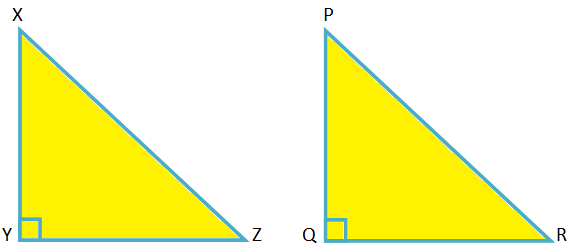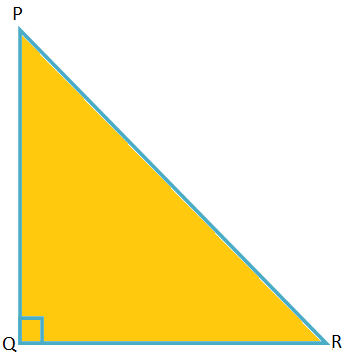Converse of Pythagoras’ Theorem
If in a triangle the sum of the squares of two sides is equal to the square of the third side then the triangle is a right-angled triangle, the angle between the first two sides being a right angle.
Given In the ∆XYZ, XY2 + YZ2 = XZ2
To prove ∠XYZ = 90°
Construction: Draw a ∆PQR in which ∠PQR = 90° and PQ = XY, QR = YZ
Proof:
In the right-angled ∆PQR, PR2 = PQ2 + QR2
Therefore, PR2 = XY2 + YZ2 = XZ2
Therefore, PR = XZ
Now, in ∆XYZ and ∆PQR, XY = PQ, YZ = QR and XZ = PR
Therefore, ∆XYZ ≅ ∆PQR (by SSS criterion of congruency)
Therefore, ∠XYZ = ∠PQR = 90° (CPCTC)
Problems on Converse of Pythagoras’ Theorem
1. If the sides of a triangle are in the ratio 13:12:5, prove that the triangle is a right-angled triangle. Also state which angle is the right angle.
Solution:
Let the triangle be PQR.
Here the sides are PQ = 13k, QR = 12k and RP = 5k
Now, QR2 + RP2 = (12k)2 + (5k)2
= 144k2 + 25k2
= 169k2
= (13k)2
= PQ2
Therefore, by converse of Pythagoras theorem, PQR is a right-angled triangle in which ∠R = 90°.
From Converse of Pythagoras’ Theorem to HOME PAGE
Didn't find what you were looking for? Or want to know more information about Math Only Math. Use this Google Search to find what you need.
Recent Articles
-
Vertical Subtraction | Examples | Word Problems| Video |Column Method
Mar 22, 25 05:20 PM
Vertical subtraction of 1-digit number are done by arranging the numbers column wise i.e., one number under the other number. How to subtract 1-digit number vertically? -
Worksheet on 11 Times Table | Printable Multiplication Table | Video
Mar 22, 25 05:08 PM
Worksheet on 11 times table can be printed out. Homeschoolers can also use these multiplication table sheets to practice at home. -
Worksheet on 10 Times Table | Printable Multiplication Table | Video
Mar 21, 25 03:46 PM
Worksheet on 10 times table can be printed out. Homeschoolers can also use these multiplication table sheets to practice at home. -
5th Grade Prime and Composite Numbers | Definitions | Examples | Math
Mar 21, 25 12:18 AM
5th grade prime and composite numbers -
14 Times Table | Read and Write Multiplication Table of 14| Video
Mar 20, 25 04:03 PM
In 14 times table we will learn how to read and write multiplication table of 14. We read fourteen times table as:One time fourteen is 14 Two times fourteen are 28 Three times fourteen are 42







New! Comments
Have your say about what you just read! Leave me a comment in the box below. Ask a Question or Answer a Question.